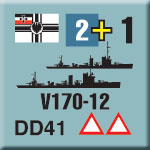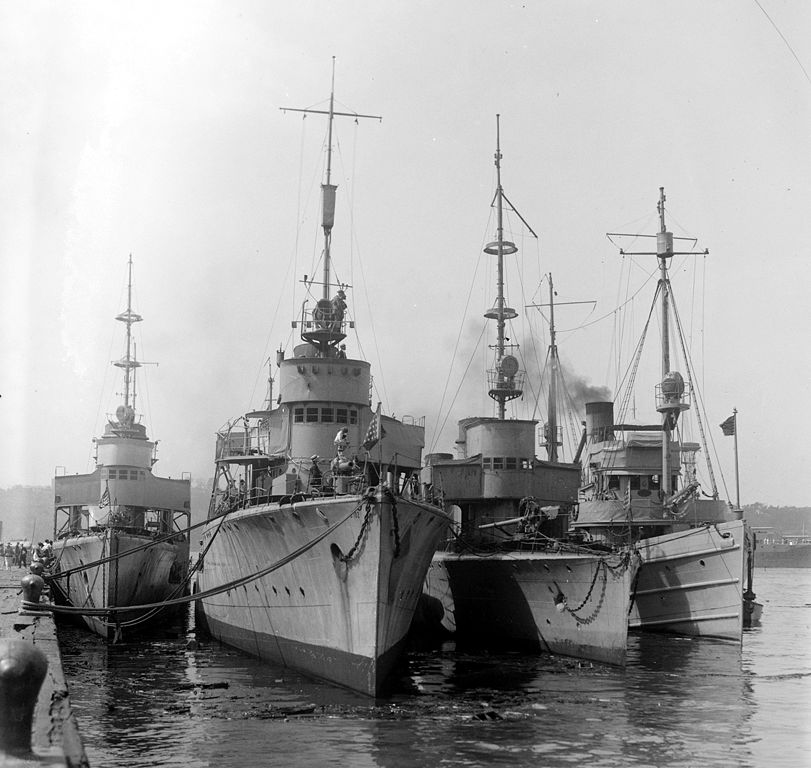Jutland 1919:
German Torpedo Boats, Part Two
by Mike Bennighof, Ph.D.
April 2021
 Alongside the gigantic Type 1916 High Seas Torpedo Boat, armed with 150mm (5.9-inch) guns and displacing twice as much as most other destroyers, German naval architects also drew up plans for a similar, merely large boat. Alongside the gigantic Type 1916 High Seas Torpedo Boat, armed with 150mm (5.9-inch) guns and displacing twice as much as most other destroyers, German naval architects also drew up plans for a similar, merely large boat.
The Type 1918Mob (Mobilisierung, or “Mobilization”) would serve as divisionstorpedoboote, or battle fleet destroyers, delivering torpedo attacks on the enemy battle line while the bigger Type 1916 fended off enemy destroyers with its heavy guns to clear the way. That would require a great many of the new boats, and the Imperial Navy ordered 53 of them: 32 under the 1917 appropriations, and 21 more under the 1918 fiscal year.
As they had done with the big Type 1916 torpedo boat, the architects drew heavily on the plans for the Russian Novik-class large destroyers that had naively been supplied by Russian shipyards looking to buy turbines from German manufacturers before the Great War’s outbreak. Novik was faster, larger and more heavily armed than the destroyers serving other nations; Germany in particular stood behind the curve with smaller vessels – “torpedo boats” in the Imperial Navy’s vernacular – than those of most other countries.
The new German torpedo boat had a layout and hull form like that of its Novik-derived larger cousin, displacing just over 1,500 tons with a length of 92 meters. That came in much smaller than the huge Type 1916’s 2,300 tons and 105 meters, but represented a substantial increase over the previous standard battle fleet torpedo boats. The Type 1913 had weighed in at 975 tons with a length of 78 meters and the Type 1916Mob, a somewhat improved version, at 1,100 tons and 82 meters.
 The new Type 1918Mob would carry four 105mm (4.1-inch) guns, a major upgrade over the three 88mm (3.45-inch) guns of the Type 1913 (many of the Type 1913 torpedo boats had their guns replaced with 105mm pieces during the course of the war; the Type 1916Mob carried three of them from the start). Like the earlier boats, the new Type 1916Mob had six torpedo tubes: two dual mounts on the centerline, and one single mount on either side of the bridge. She was also to be fitted to carry and lay forty mines, a substantial increase over the earlier models. The new Type 1918Mob would carry four 105mm (4.1-inch) guns, a major upgrade over the three 88mm (3.45-inch) guns of the Type 1913 (many of the Type 1913 torpedo boats had their guns replaced with 105mm pieces during the course of the war; the Type 1916Mob carried three of them from the start). Like the earlier boats, the new Type 1916Mob had six torpedo tubes: two dual mounts on the centerline, and one single mount on either side of the bridge. She was also to be fitted to carry and lay forty mines, a substantial increase over the earlier models.
The bigger hull gave the Type 1918Mob a steadier gun platform for the heavier artillery, and much better seakeeping in the rough waters of the North Sea. German torpedo boats had improved as high-seas warships since the earliest classes, but even the more recent versions still wallowed in heavier seas to a much greater extent than their British counterparts. The Type 1918Mob was intended to give the High Seas Fleet a destroyer that could match British performance, allowing the battle fleet to remain at sea in the same conditions as the enemy.
The new torpedo boat was the first German warship with geared turbines; she had half again the power output of the previous types – 38,000 horsepower compared to 26,000 - and therefore considerably more speed (35 knots, compared to 32 knots for earlier torpedo boats). By comparison the new light cruisers Brummer and Bremse, also equipped with geared turbines, developed 42,000 horsepower on a displacement four times that of the new torpedo boat, but only made 28 knots. The geared turbines gave the new torpedo boats much greater range than the earlier vessels, allowing them to steam much more economically at cruising speed.
All of those additional capabilities came at a price that the German Admiralty had not wished to pay in earlier years. The new, larger boats would likely have been less maneuverable than the smaller types the Germans had favored; battle experience showed that this feature did not matter so much in fleet actions, but did in close coastal waters. In response, the German Navy built a series of much smaller coastal torpedo boats to fill that role.
The new torpedo boat also had a much larger crew than the old, 117 men for the Type 1918Mob compared to 85 for the Type 1913. Alfred von Tirpitz had been firm in his desire that a torpedo boat remain small enough that her crew could be commanded by a single officer, thereby holding down the number of officers needed by the torpedo branch. That would no longer be possible with the larger boats, at least doubling the number of sea officers.

German torpedo boats in American hands post-war. From left, V43 (Type 1913); G102 (ex-Argentine destroyer San Luis, taken over during construction); S132 (Type 1916Mob); American minesweeper Redwing.
Of the first 32 boats ordered, 30 began construction in 1918 and two were never begun. Contracts for the 21 authorized for the 1918 fiscal year were placed, but none of the boats began construction before the war – and the Imperial government responsible for paying the bills - ended.
By the time construction began, German industry faced crippling shortages of raw materials including high grade steel and of labor. Shipyards employed fewer female workers than did munitions factories, and even a program to furlough soldiers from the front to spend time in vital industries did not ease the problem. Shipyards strained to build new submarines to feed the needs of unrestricted undersea warfare, and to service and repair the existing warships now feeling the strain of four years of wartime use.
Unable to fulfill its obligations in that economic environment, Howaldtswerke of Kiel, entrusted with contracts for half of the initial order, even sub-contracted four of them to Stettiner Oderwerke, a tiny shipyard previously only known for building tugboats, river craft and small seaside excursion steamers. Oderwerke proved unable to finish them, either.
None of the boats laid down would be completed as warships; thanks to the huge post-war shortage of merchant shipping two were completed as four-masted sailing ships and two more as steam-powered coastal freighters.
As a warship design, the Type 1918Mob was similar to the fleet destroyers built by other maritime powers at the end of the Great War. The American “four-stack” destroyers were smaller (1,100 tons) with the same main gun armament but twice as many torpedo tubes. The British W-class likewise came in a little smaller than the German boats, with four 4-inch guns and six torpedo tubes.
The Type 1918Mob torpedo boat appears in Great War at Sea: Jutland 1919 as the V170 class destroyer; the Imperial German Navy also used the same designation system for its minesweepers (“Type” and year of design) so we needed to use something else for the destroyers (V170 came first in the numberes issues to the Type 1918Mob - Imperial German destroyers carried numbers rather than names).
You can order Jutland 1919 right here.
Sign up for our newsletter right here. Your info will never be sold or transferred; we'll just use it to update you on new games and new offers.
Mike Bennighof is president of Avalanche Press and holds a doctorate in history from Emory University. A Fulbright Scholar and NASA Journalist in Space finalist, he has published more books, games and articles on historical subjects than anyone should.
He lives in Birmingham, Alabama with his wife, three children, and his Iron Dog, Leopold.
|
